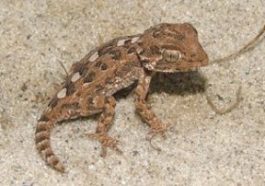Gecko night vision
Certain geckos can tell colors apart even in dim moonlight.
By Emily Sohn
Try this: Go outside at night with a box of crayons and a blank piece of paper. Without looking at the crayon labels, pick one out and draw something on a piece of paper. Then, look at your drawing and try to guess what color it is. Chances are, you’d be wrong. That’s because people have a hard time seeing colors in the dark.
Geckos, apparently, don’t have this problem. They’re the first vertebrates known to be able to tell the difference between blue and gray, even when the light is very dim. (Vertebrates are animals that have spines. Fish, amphibians, reptiles, birds, mammals, and people are vertebrates.)
 |
|
In dim light, the helmet gecko can tell blue from gray, even when people can’t.
|
| Lina S.V. Roth |
Most vertebrates have two kinds of cells in their eyes that help them see: cones and rods. Cones detect colors when there’s lots of light. Rods are more sensitive, but they see only in black and white, so they’re more useful at night.
Lizards are unusual because their eyes don’t have rods. This might be because most lizards are active only during the day and don’t need the supersensitive rod cells. A group of researchers in Sweden were especially interested in a type of lizard in Africa called the helmet gecko, which is actually most active during the night.
To test the vision of these creatures, the scientists trained a male and a female gecko to eat crickets off of tongs that were labeled with either a blue card or a gray one. With blue, the geckos got a big, juicy bug. With gray, they got a gross cricket that had been dipped in salty water. The geckos learned that blue meant yummy. Gray meant yucky.
 |
|
A gecko’s pupil is nearly closed in bright light (left) and wide open in dim light (right).
|
| Lina S.V. Roth |
Then, the scientists tested the lizards under low levels of light, similar to dim moonlight. In these conditions, the researchers couldn’t tell the difference between gray and blue. The geckos, however, snatched crickets off of blue cards twice as often as they picked crickets off of gray ones. The result suggests that the geckos could see the difference between the colors.
Researchers now wonder whether other animals that are active at night or live underground or swim deep in the ocean have the same ability. Future research might eventually help us understand what the world looks like through the eyes of frogs, geckos, and other creatures that go bump in the night.







